
© 2024 | All Right Revered.
A detailed comparison of two of the most popular programming languages Ruby vs. Python.

Chief Technology Officer
A tech builder, mastering engineering processes and venture building by creating rapid, scalable, and solid product solutions. A staunch advocate for the disruptive capabilities of AI Co-Pilots in the software service industry.
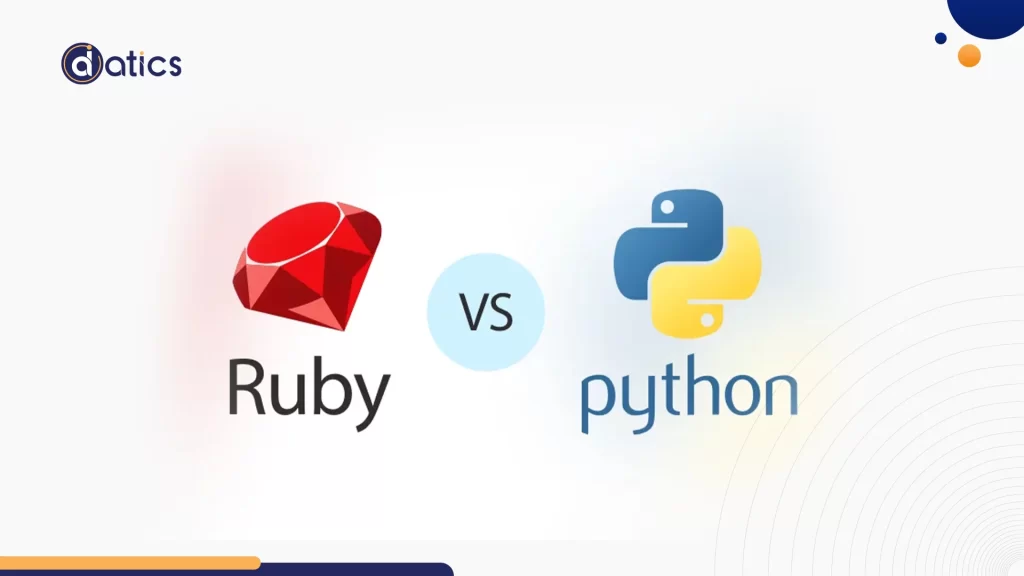
Choosing a programming language like Ruby or Python may not be an immediate concern for you. Depending on your business stage, you might be starting a tech project and seeking the right tools or representing a well-established company strategizing for efficient scaling.
In both scenarios, your chosen programming language is crucial, significantly impacting your business operations.
Whether you’re the innovative founder or CTO of a promising startup, a tech decision-maker at a rapidly growing scale-up, or an experienced engineering director of an enterprise aiming to maintain a competitive edge in the tech landscape, the choice of a programming language is of substantial concern.
This decision holds considerable influence over the direction and success of your projects.
Your chosen programming language is crucial, significantly impacting your business operations.
Through this extensive blog post, we’re committed to comprehensively addressing your concern of choosing the best programming language. For this pupose, we have choosen Ruby and Pyhton, two of the most widely used programming languages for software development.
Our objective is to guide you through the intricate decision-making process related to the Ruby vs. Python choice. The ever-evolving nature of technology can make selecting the right programming language feel overwhelming. However, by methodically assessing their attributes, you’ll be well-equipped to make an informed decision about which programming language best suits your upcoming project.
Python and Ruby, two programming languages with notable similarities, present unique qualities that cater to a diverse range of programming needs. Let’s first dive into Python, a programming powerhouse with its own unique set of tricks up its sleeve.
Python, created in 1991, is an interpreted, high-level general-purpose language featuring dynamic typing and garbage collection.
Guido van Rossum, the brains behind Python, embedded the language with a profound philosophy: code readability. This focus on clear and understandable code is a defining feature of Python’s design.
While Python can handle procedural programming, it leans heavily towards an object-oriented structure, which simplifies the process of writing not just functional but also highly comprehensible code.
Python doesn’t stop there; it’s also big on structured programming, promoting clean and high-quality code through well-organized control flows. You’ll spot this in features like if-then-else statements and nifty loops, like while and for loops. Plus, Python is a friend to functional programming paradigms too.
But what really makes Python unique is its use of ‘significant whitespace.’ In other languages, you’d see curly brackets used to organize code, but Python takes a different approach. It uses spaces and tabs to define code blocks, which can be a bit polarizing among programmers. Some love it for the enhanced readability it brings, while others have a different opinion.
Python’s appeal extends to its comprehensive library, often referred to as ‘batteries included’. It’s got a tool for almost everything, making development a breeze.
Lastly, there’s something called The Zen of Python, a concise manifesto that captures Python’s core philosophies. It champions simplicity over complexity, emphasizes the importance of readable code, and encourages having one clear way to get things done. These principles make Python an attractive choice for developers who value functionality and clarity in equal measure
Python, renowned for its versatility and prowess, emerges as a programming language popular not only for its elegant simplicity and impeccable readability but also for the vast expanse of libraries and frameworks within its ecosystem.
These invaluable resources serve as a lifeline for developers, simplifying tasks across diverse technical domains and providing ready-made solutions to a multitude of challenges.
Frameworks in Python automate many aspects of application development, offering structured guidelines and pre-built modules to accelerate the development process. Let’s delve into the world of Python frameworks and introduce you to the different types before we explore some of the popular ones.
Full Stack Framework: This comprehensive framework offers an all-in-one solution for web development. It covers everything from form validation to database connectivity, providing a robust foundation for building web applications.
Micro Framework: In contrast, micro frameworks are lightweight and minimalist. They offer flexibility but require developers to manually add features like form validation and data abstraction layers. Microframeworks are ideal for small-scale applications.
Asynchronous Framework: These frameworks leverage the async library to handle multiple connections simultaneously, making them suitable for larger applications that require concurrent processing.
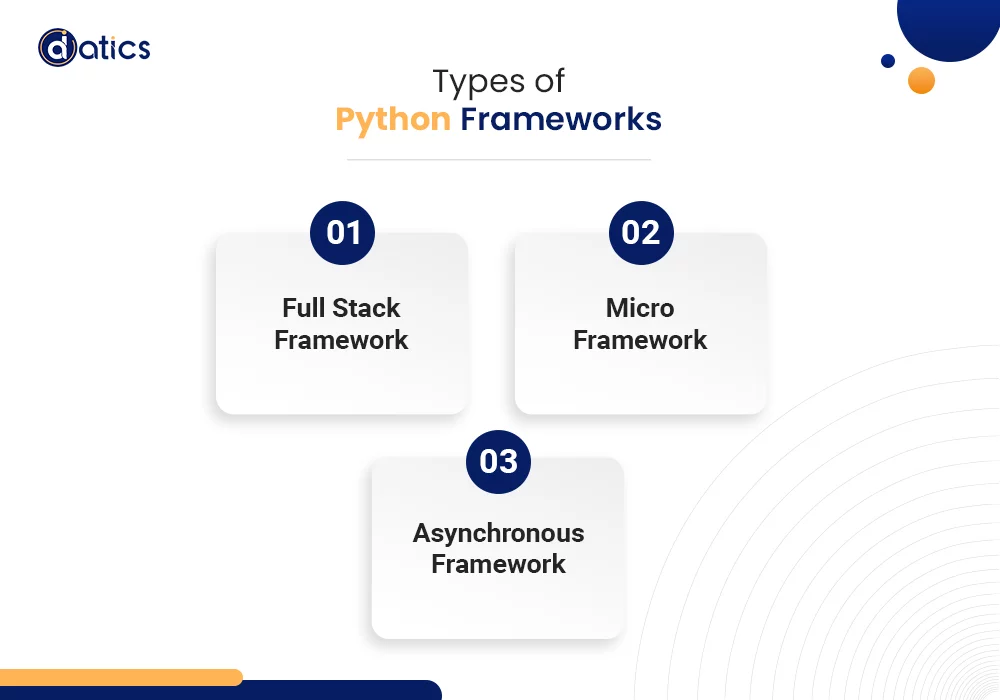
Django stands out as a popular open-source full-stack Python framework, celebrated for its robust feature set and unwavering commitment to the “Don’t Repeat Yourself” (DRY) principle. Offering a comprehensive solution for web development, Django’s key features include:
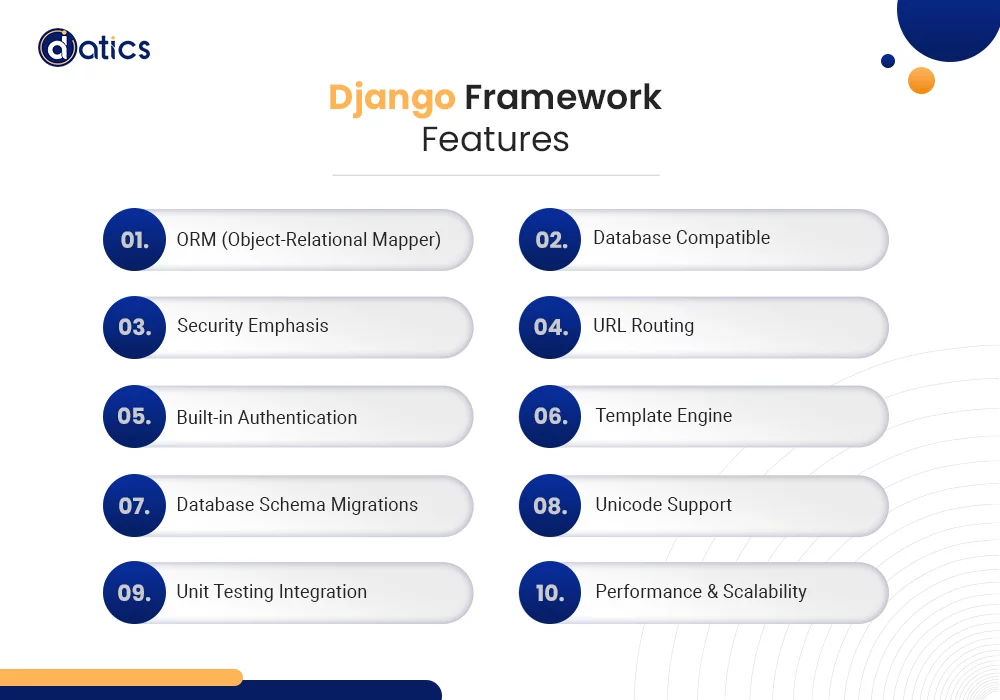
ORM (Object-Relational Mapper): Django employs ORM to seamlessly map objects to database tables, embracing an object-oriented approach to database interactions.
Database Compatibility: It boasts compatibility with various databases, such as Oracle, MySQL, PostgreSQL, and SQLite.
Security Emphasis: Django places paramount importance on security, equipping developers with robust tools to safeguard against common web vulnerabilities.
URL Routing: With Django, crafting clean and organized URLs is effortless, thanks to its URL routing capabilities.
Built-in Authentication: Django simplifies user authentication with its built-in features.
Template Engine: It incorporates a versatile template engine for dynamic web page rendering.
Database Schema Migrations: Smooth transitions with database schema migrations come standard with Django.
Unicode Support: Django’s support for Unicode ensures suitability for internationalization and localization.
Unit Testing Integration: Developers benefit from built-in support for unit testing to maintain code quality.
Performance and Scalability: Django delivers high-performance web applications with scalable architecture.
Flask, in contrast, emerges as a lightweight micro-framework for Python, offering flexibility and simplicity tailored to developers’ needs. While it may not provide an extensive suite of built-in features like Django, Flask excels in adaptability. Its primary features encompass:

Lightweight Nature: Flask prides itself on minimalism, refraining from imposing rigid application structures, granting developers the freedom to mold applications as desired.
Jinja2 Templating: Leveraging the Jinja2 template engine, Flask facilitates web page rendering elegantly.
Unicode Support: Flask embraces Unicode encoding, catering to internationalization needs.
Built-in Development Server: The presence of a built-in development server simplifies testing and debugging.
Efficient HTTP Request Handling: Flask adeptly manages HTTP requests and responses.
WSGI Compliance: Flask aligns seamlessly with the Web Server Gateway Interface (WSGI) standard.
Unit Testing Support: Robust support for unit testing ensures reliability.
RESTful API Creation: Flask offers capabilities for crafting RESTful APIs.a
FastAPI, a modern and high-performance web framework, specializes in swift and efficient API development. Known for its asynchronous capabilities and automatic data validation, FastAPI excels with the following features:
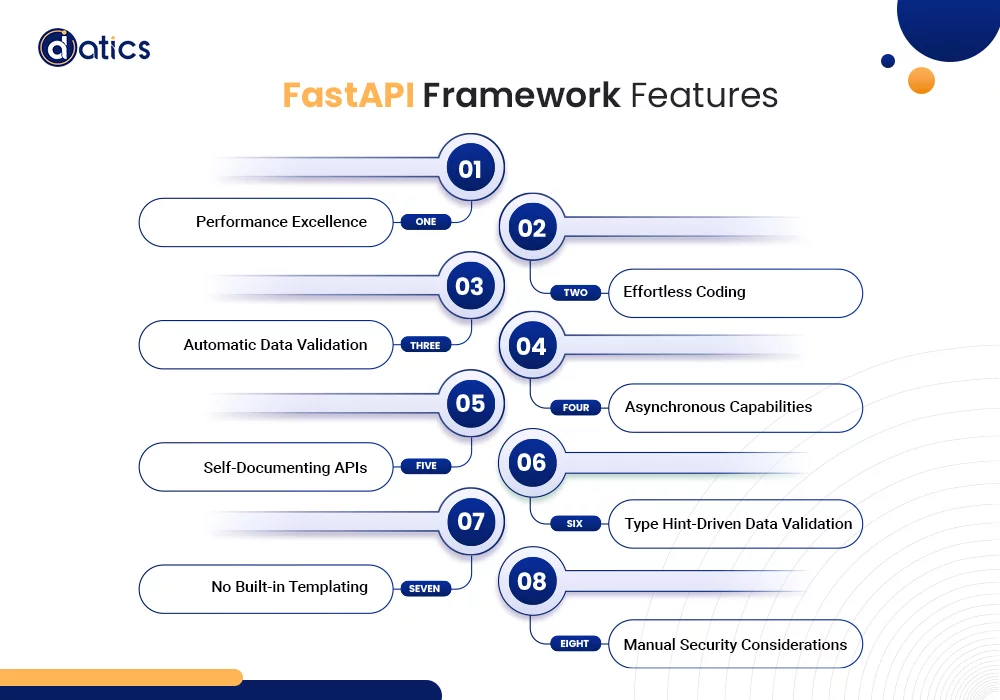
FastAPI, a modern and high-performance web framework, specializes in swift and efficient API development. Known for its asynchronous capabilities and automatic data validation, FastAPI excels with the following features:
Performance Excellence: Leveraging async/await syntax and type hints, FastAPI achieves remarkable performance and scalability.
Effortless Coding: Developers appreciate FastAPI’s clear and concise syntax for defining routes, parameters, and response models, streamlining development.
Automatic Data Validation: FastAPI harnesses Python type hints to automatically validate incoming data, significantly reducing error risks.
Asynchronous Capabilities: Supporting asynchronous code, FastAPI efficiently handles concurrent connections.
Self-Documenting APIs: FastAPI impressively generates interactive API documentation based on type hints, enhancing understandability and testability.
Type Hint-Driven Data Validation: Type hints drive automatic data validation and self-documentation within APIs.
No Built-in Templating: Unlike Django and Flask, FastAPI omits a built-in template engine.
Security Considerations: While offering some security features, FastAPI leaves certain security aspects to developers for manual handling.
Python stands as a versatile programming language, often likened to a “Swiss Army Knife” due to its myriad benefits. Whether you’re spearheading a startup, overseeing a scaling enterprise, or navigating the territory in between, Python in 2024 offers compelling reasons to be your language of choice:
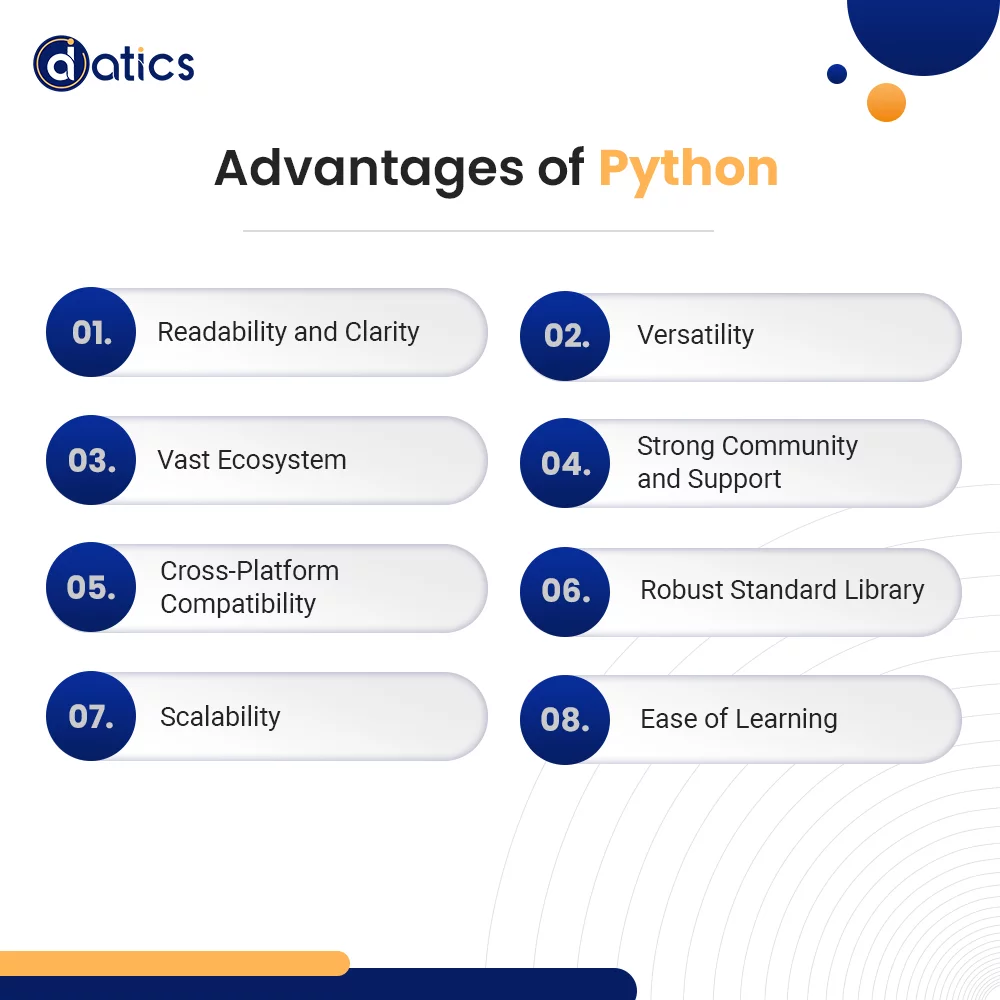
Python’s code is akin to plain English, ensuring readability and clarity. This not only accelerates development but also simplifies maintenance and fosters collaboration among team members. For founders and businesses, this translates to faster development cycles and reduced debugging times.
Python’s adaptability is a standout feature. It excels in web development, scientific computing, data analysis, artificial intelligence, machine learning, and more. This flexibility empowers startups to pivot and established enterprises to tackle diverse projects using the same language.
Python boasts an extensive ecosystem of libraries and frameworks, known as the Python Package Index (PyPI). These ready-made tools streamline development, saving time and effort. From Django and Flask for web development to NumPy and Pandas for data analysis, Python has it all.
Python enjoys an active, inclusive community of developers and enthusiasts. This offers access to abundant resources, forums, and documentation. Founders and businesses can leverage this support for issue resolution and staying updated with industry trends.
Python works seamlessly on various operating systems, including Windows, macOS, and Linux. This cross-platform compatibility broadens your potential user base as applications run smoothly across diverse environments.
Python’s “batteries included” approach means it comes with a comprehensive standard library covering a wide range of functionalities. This minimizes the need for external dependencies, simplifying development.
Python handles complex, large-scale projects effectively. Whether starting small or aiming for rapid growth, Python’s scalability ensures it can meet evolving needs.
Python’s gentle learning curve makes it ideal for beginners and experienced developers alike. This accessibility enables quick onboarding of team members, maintaining high productivity levels.
Wondering if Python aligns with your project needs?
If you seek a user-friendly language that excels in versatile application development, Python might be your answer. But what specific scenarios suit Python best?
The following list offers clarity:
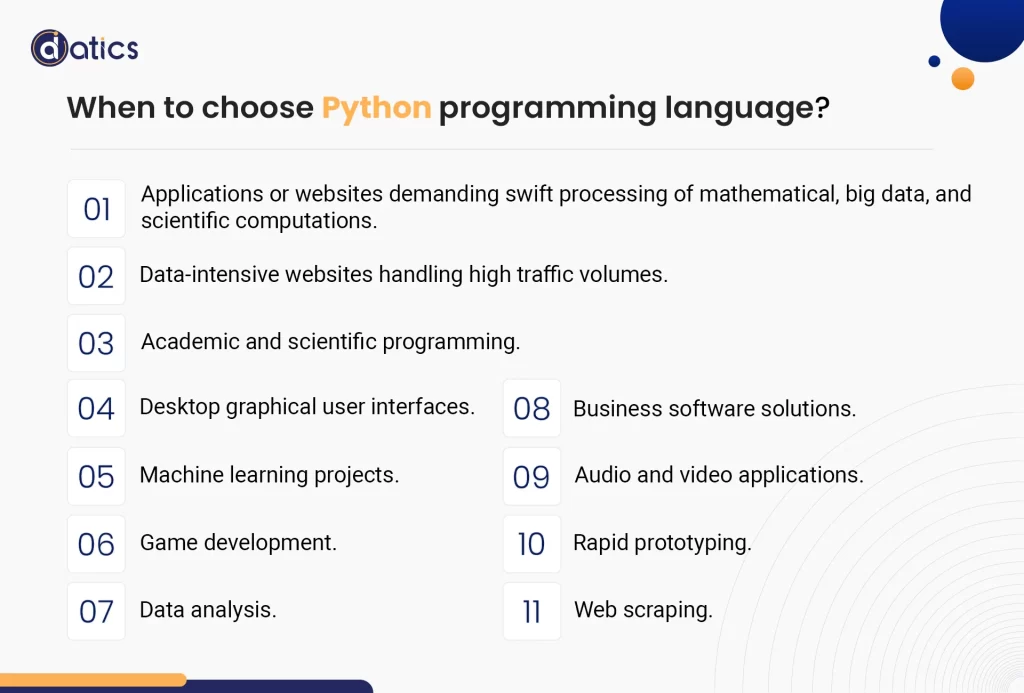
If you value code stability and maintainability, Python is a solid choice.
To grasp the potential advantages of Python for your business, consider the diverse range of global companies that leverage Python’s adaptability and versatility:
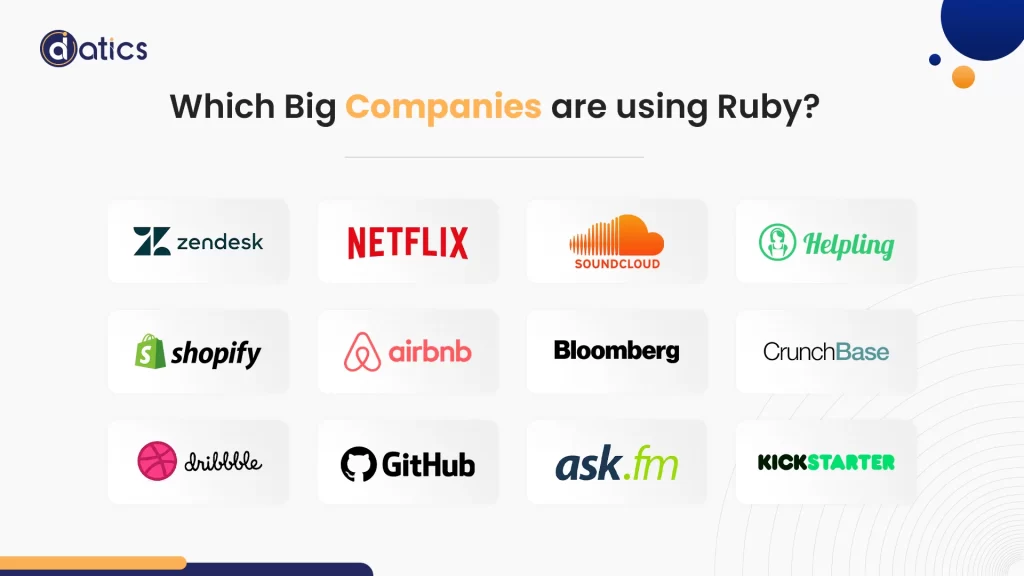
Ruby isn’t your run-of-the-mill programming language. It was first launched just four years after Python, thanks to the vision of Yukihiro “Matz” Matsumoto. His mission? To create a scripting language that excelled in the world of object-oriented programming, a feat he felt existing languages fell short of achieving.
Now, what sets Ruby apart?
It’s not just about web development, although it shines there. It’s also a go-to for data analysis, prototyping, and those crucial proof-of-concept projects.
But how does Ruby work its magic?
Well, it’s an interpreted language, so it might not win any speed races against those massive compilers that turn code directly into machine language. Ruby takes it slow, reading and executing code line by line. But here’s where it gets interesting: Ruby is versatile.
You see, it supports multiple programming paradigms. There’s object-oriented programming, which lets you work with data intuitively using objects. Then there’s functional programming, where pure functions take the lead in crafting your program. And don’t forget procedural programming, a top-down approach that guides your code toward its objectives.
Ruby also gives you some leeway with variable types. It’s dynamically typed, meaning you don’t need to be overly strict about defining variable types up front. This results in code that’s more concise and readable. Contrast that with statically typed languages, which are stricter but excel at catching type errors early in the game.
Ruby even takes care of memory management for you. It boasts garbage collection, an automatic process that handles memory allocation tasks. In simple terms, it keeps what your program still needs in memory and tidily disposes of the rest.
So whether you’re diving into web development or embarking on a data analysis journey, Ruby offers a versatile and approachable option.
Ruby’s web development landscape is enriched by a variety of robust frameworks, each designed to simplify and accelerate the process of building web applications in Ruby.
These frameworks cater to diverse development needs, offering convention-driven structures, lightweight flexibility, and strict adherence to object-oriented principles.
Below are some of the most popular Ruby frameworks and their unique features.
Ruby on Rails, commonly known as Rails, is a comprehensive Ruby framework famous for its developer-friendly conventions and emphasis on efficient coding practices. It encourages simplicity and adheres to conventions that streamline development.
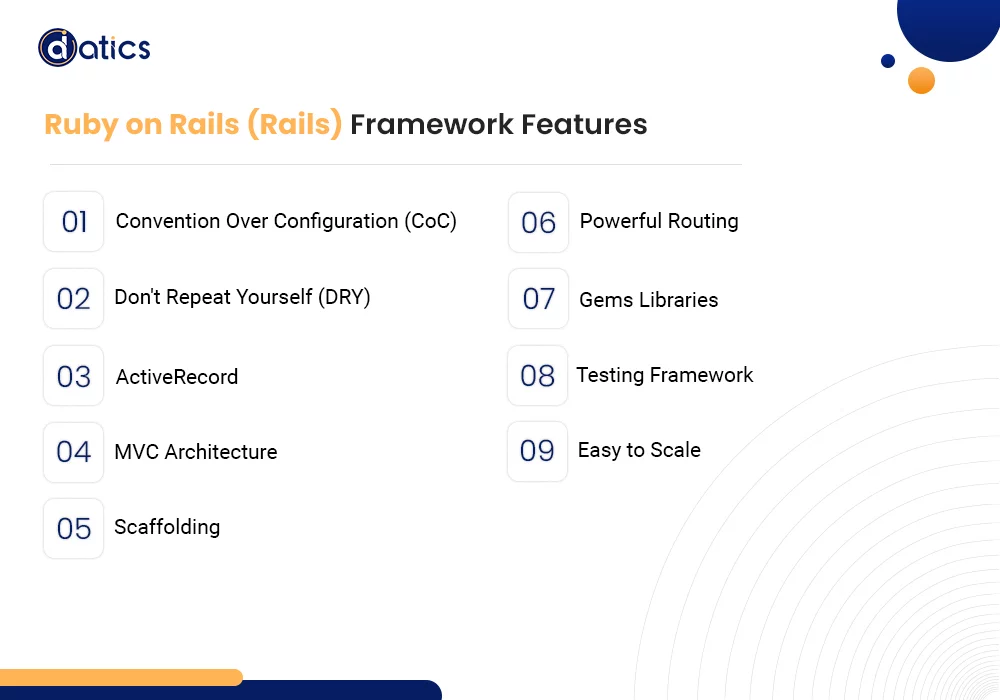
Convention Over Configuration (CoC): Rails reduces decision fatigue by enforcing sensible conventions, allowing developers to concentrate on application-specific logic.
Don’t Repeat Yourself (DRY): Rails promotes code reusability and maintainability, minimizing redundant code.
ActiveRecord: This built-in ORM (Object-Relational Mapping) simplifies database interactions, enabling developers to work with databases using Ruby classes.
MVC Architecture: Rails follows the Model-View-Controller pattern, ensuring a clean separation of concerns.
Scaffolding: Rails offers automatic code generation for common tasks, speeding up development.
Powerful Routing: A robust routing system simplifies URL management and customization.
Gems: Rails boasts a vast ecosystem of gems (libraries) that extend its functionality and speed up development.
Testing Framework: It includes a built-in testing framework for writing unit and integration tests.
Community Support: A large and active community offers resources, plugins, and solutions for common challenges.
Scalability: Rails applications are easy to scale, making it ideal framework for both startups and big enterprises.
Sinatra is a lightweight and flexible Ruby framework designed to build small to medium-sized web applications. It offers minimalistic simplicity, providing developers the flexibility to select components and libraries based on their project’s requirements.
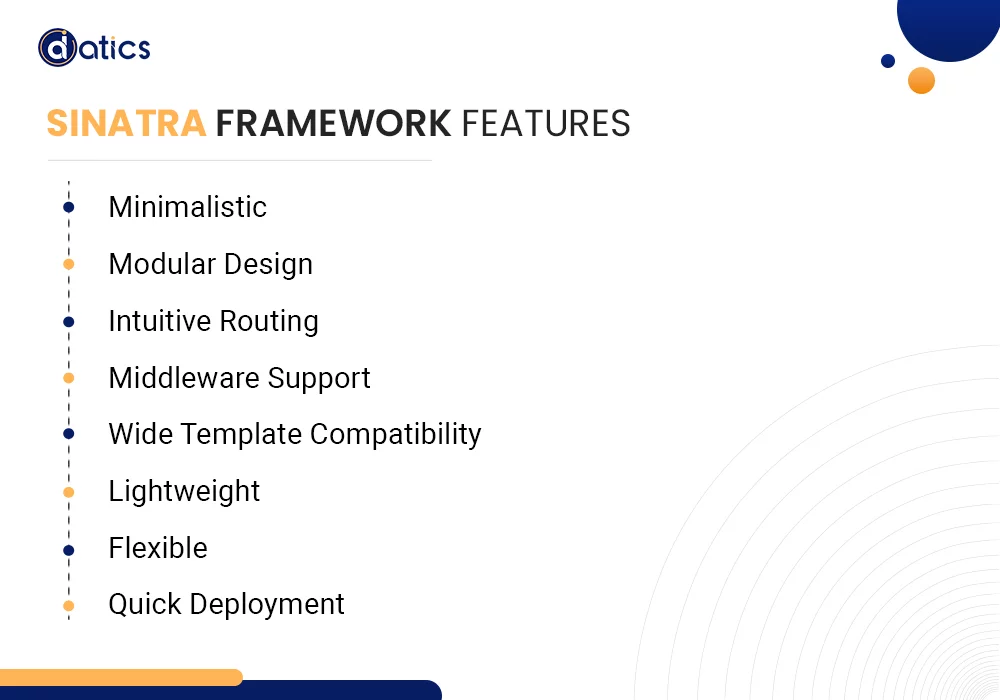
Minimalistic: Sinatra adopts a minimalistic approach, simplifying setup and usage.
Modular Design: Developers can structure their application as a collection of modular components.
Routing: Sinatra provides a straightforward and intuitive routing system for defining HTTP routes and actions.
Middleware Support: It allows the use of middleware for customizing request and response handling.
Templates: Sinatra is compatible with various template engines, enabling dynamic content generation.
Testing: The framework includes testing support for creating unit and integration tests.
Rack Compatibility: Sinatra is built on the Rack interface, making it compatible with other Rack-based middleware.
Lightweight: Its small footprint and low overhead make it suitable for lightweight applications.
Flexibility: Developers have the freedom to select libraries and components, adapting to diverse project requirements.
Quick Deployment: Sinatra applications deploy rapidly and can be hosted on various platforms.
Hanami is a Ruby framework that prioritizes modularity, object-oriented design, and adherence to the single responsibility principle. It caters to developers seeking structured and maintainable code.

Modular Design: Hanami encourages modular application design, enabling developers to create distinct and independent components.
Single Responsibility: The framework advocates the single responsibility principle, enhancing code organization.
Database Integration: Hanami includes built-in support for database migrations, simplifying database-related tasks.
Template Rendering: It offers a flexible template rendering system for generating dynamic views.
Router: Hanami provides a powerful router for defining routes and actions.
Security: The framework emphasizes security practices to safeguard against common vulnerabilities.
Performance: Hanami is renowned for its performance and scalability, making it suitable for a wide range of applications.
Websockets: It supports WebSockets for building real-time features in applications.
Flexible Configuration: Hanami offers flexibility in configuring application settings and components.
Strict Architecture: The framework enforces a structured and strict architecture, enhancing code maintainability.
Community: While smaller than Rails, Hanami has an active and growing community that provides resources and support.
Ruby stands out for its elegance and developer-friendly nature, offering unique advantages that align with various programming needs:
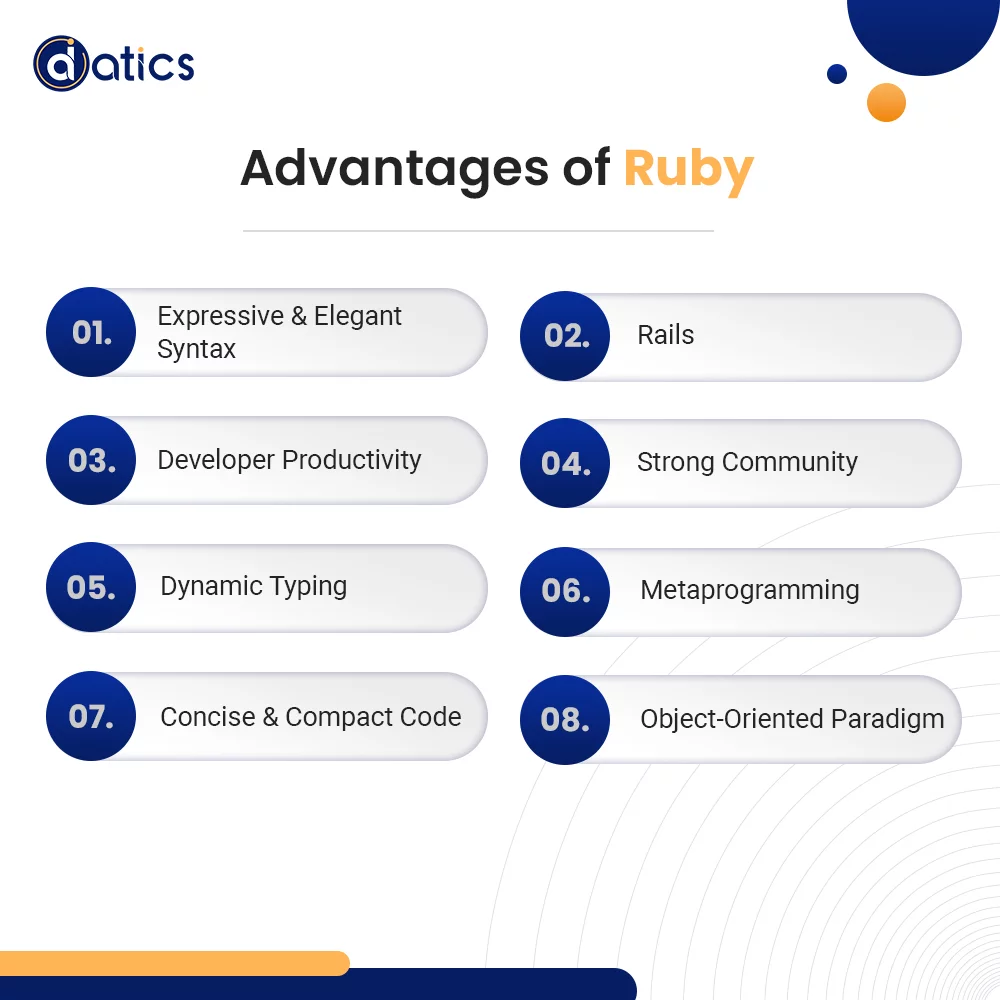
Ruby is renowned for its elegant and highly expressive syntax, often compared to natural language. This readability simplifies writing clean, concise code, reducing errors, and enhancing overall code quality.
A Robust Web Framework: Ruby on Rails (Rails) is a web development framework built on Ruby’s foundation. It prioritizes developer-friendly features like convention over configuration (CoC) and doesn’t repeat yourself (DRY) principles. Startups can rapidly develop web applications with efficiency using Rails.
Ruby’s focus on developer happiness translates into increased productivity. This is particularly advantageous for startups aiming to swiftly build and iterate on their products. Ruby’s straightforward syntax and well-structured codebase contribute to this productivity boost.
Ruby boasts a dedicated and passionate developer community that drives its growth and evolution. This provides access to a wealth of resources, Ruby gems (packages), and tutorials, supporting founders and businesses through collaboration.
Ruby’s dynamic typing allows flexible variable types, reducing the need for strict type declarations. This flexibility speeds up development and adapts the code as project requirements evolve.
Ruby’s metaprogramming capabilities empower developers to write code that can modify itself during runtime, offering powerful options for building dynamic and flexible applications.
Ruby’s emphasis on brevity means you can often achieve more with fewer lines of code. This conciseness accelerates development and simplifies maintenance.
Ruby aligns seamlessly with the object-oriented paradigm, simplifying code organization and design as everything in Ruby is an object.
Curious about Ruby’s compatibility with your objectives? If you desire an approachable language that encourages individual creativity while maintaining elegance and power, Ruby could be your solution.
For those who prefer concise lists, here are scenarios where Ruby shines:
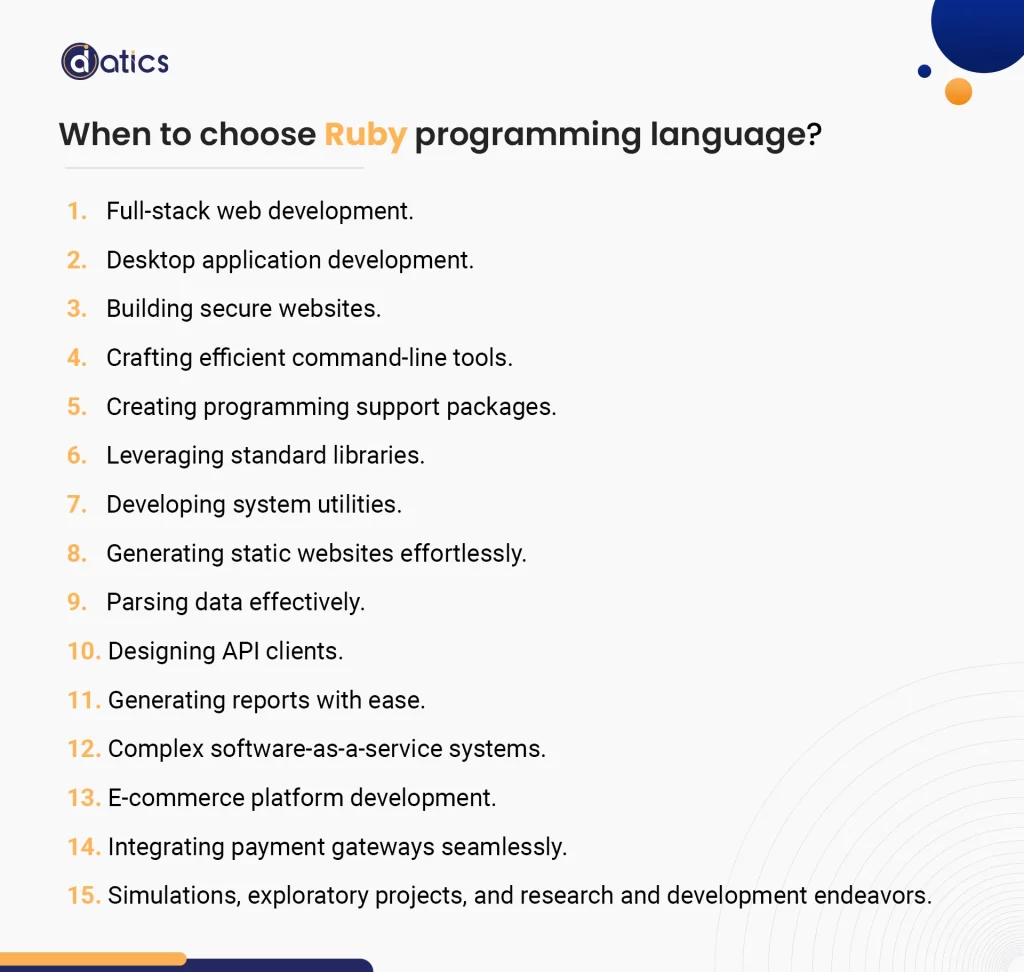
Although Ruby may have seen shifts in popularity over the past decade, it continues to shine in the realms of object-oriented programming and Agile development.
Explore the applications of Ruby on Rails in these 10 diverse companies of varying sizes in 2024:

In this section, we’ll conduct a head-to-head comparison, exploring crucial aspects that can influence your choice between these two dynamic languages.
When evaluating the web frameworks of Ruby and Python, namely Django and Ruby on Rails, you’ll notice they share significant resemblances.
Both adhere to the classical model-view-controller (MVC) pattern, offer libraries for expanding functionalities, and maintain repositories—PyPi for Python and RubyGems for Ruby.
Verdict: Both frameworks perform exceptionally well, and there’s no clear frontrunner.
Python’s dominance in the realm of artificial intelligence (AI) is evident, thanks to its comprehensive libraries, making it the go-to language for AI projects. In contrast, Ruby exhibits potential but needs to refine its machine learning and AI libraries to match Python’s capabilities.
Verdict: In the Ruby vs. Python faceoff for machine learning, Python emerges as the unequivocal winner.
RubyGems and PyPi offer vast repositories, enabling developers to enrich their code with feature-rich libraries. However, Python enjoys a broader spectrum of libraries compared to Ruby. Python’s libraries, credited to its popularity and maturity, also come with well-crafted documentation.
Verdict: For Ruby vs. Python documentation and libraries, Python prevails with its extensive resources.
Both Python and Ruby embrace the ethos of test-driven development (TDD). Python employs PyTest and unit tests to encourage code quality through frequent testing. Ruby introduces behavior-driven development (BDD) via RSpec, aligning code with requirements defined by developers.
Verdict: In the testing landscape, both languages are on an equal footing, but Ruby’s inclusion of BDD distinguishes it.
Python and Ruby, both high-performing interpreted languages, belong to the open-source realm. Comparing their performance can be subjective since both can optimize libraries to suit specific needs.
Verdict: When it comes to Ruby vs. Python performance, it’s a tie, as both open-source languages offer potential for optimization.
Ruby’s elegant syntax employs simple English words, while Python’s syntax resembles natural language, further simplifying the learning process. Python’s user-friendliness gives it an advantage in the Ruby vs. Python learning curve comparison.
Verdict: Here, Python emerges as the more accessible language due to its straightforward syntax.
Both Ruby and Python, as open-source languages, boast extensive communities. Ruby gained popularity, particularly with Ruby on Rails, but lags behind Python in terms of widespread adoption. Python’s gentle learning curve attracts a diverse and extensive developer base.
Verdict: For Ruby vs. Python community support, Python stands out with a larger and more varied community.
Python’s status as a beginner-friendly language is well-established. In contrast, Ruby’s popularity is closely linked to the demand for Ruby on Rails, a frequent topic in the software development world.
Verdict: Python and Ruby are evenly matched in terms of popularity, each excelling in its respective domain.

Share the details of your project – like scope, timeframe, or business challenges. Our team will carefully review them and get back to you with the next steps!

© 2024 | All Right Revered.
This guide is your roadmap to success! We’ll walk you, step-by-step, through the process of transforming your vision into a project with a clear purpose, target audience, and winning features.